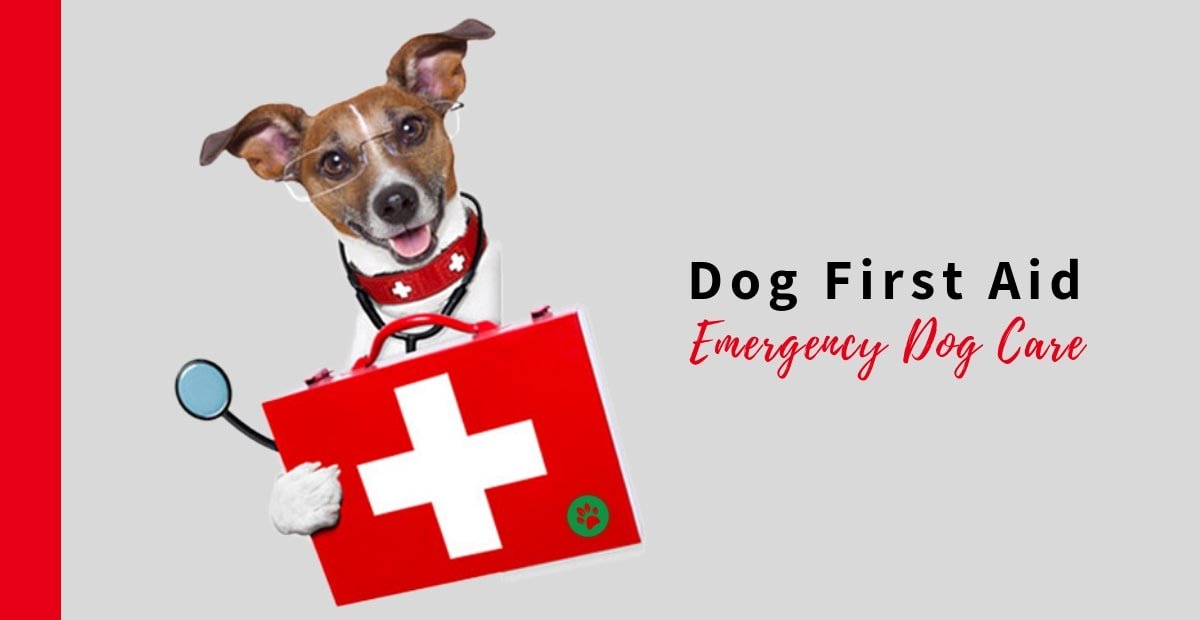Giving A Dog First Aid Treatment In Emergencies
(FTC Disclosure: If you make a purchase via a link on this page, I may receive a small commission, at no added cost to you.)

Overview
Dogs are like children - they play hard and they get boo-boos. Knowing how to give appropriate first aid to your dog can save him prolonged pain, shock, and even save his life.
The key to responding well to an emergency is to be prepared. Having a fully-stocked first aid kit and knowing how to use everything in the kit is important.
Also, be sure you know where you should go if you have an emergency, especially when it happens after hours. It is a good idea to put a list of emergency numbers (your vet's, animal hospital's, your local animal poision control center's) in the first aid kit.
Never give a dog first aid treatment that is not muzzled and restrained. Your dog may be an angel when he is fine and well, but he may bite (yes, even you!) when he is in pain and in shock.
Remember to take care to protect yourself. Safety first.
How to Give CPR to Dogs
If your dog is unconscious, but you do not know why, check first to see if he has choked on something:
- Open his mouth. Look for a foreign object that may have blocked the airway (e.g. chunk of food, a toy, etc.) If you see the object, try to remove it preferably using a pair of tweezers or other tools instead of your hands.
- If you cannot get to the foreign object, try to dislodge it - Put your hands on each side of your dog's rib cage. Apply firm and quick pressure 3-4 times. Alternatively, lay your dog on one side. Using your palm, strike the side of his rib cage firmly 3-4 times.
If your dog is unconscious and not breathing, but you cannot see anything blocking his airway, then you will need to give him CPR. Here is a very useful video teaching you how:
You may want to check with your local Red Cross to see if you can attend a pet CPR class for some practical training.
How To Give A Dog First Aid Treatment In These Situations
In an emergency, first aid is not a substitute for veterinary treatment. However, before you are able to get your dog to a vet, knowing how to provide emergency dog care to your pet in these situations can be of great help:
Dog First Aid for Bites and Stings
Before treating your dog for bites and stings, find out if possible the culprit that has bitten or stung your dog to ensure that she is being treated in the most appropriate way. For example, if your dog has been stung by a bee or wasp, a good treatment is to put a slice of freshly cut onion on the affected area.
If the culprit is unknown, try to treat your dog to minimize the pain, swelling, and possible infection that may arise from the bite or sting. However, if your dog has a serious reaction to the bite or sting (e.g. intense swelling especially on the face, or difficulty in breathing), then please get her to a vet immediately.
Home Remedies for Bites and Stings
Herbal and homeopathic remedies are effective in alleviating pain and swelling caused by insect bites and bee stings. Antimicrobial herbs can also be used to prevent infection.
- Rosemary: Using an infusion of rosemary to bath the affected area can have a soothing effect.
- Tee tree: If your dog is not sensitive to tee tree essential oil, try applying a diluted tee tree oil (4-6 drops of oil to one oz. of carrier oil) to the affected area. Tee tree has antimicrobial properties and will prevent infection.
- St. John's wort / Oregon grape / Echinacea: Use the oil of St. John's wort and combine it with bentonite clay. Apply the clay mixture to the affected area. This is effective for bee stings. The clay will help draw out the poison and the anti-inflammatory properties of St. John's wort will help alleviate some of the pain. Alternatively, use a tincture of oregon grape or echinacea with bentonite clay and apply it to the affected area.
- Parsley: Take a handful of fresh parsley and mash it with a little bit of water. Rub it on the bee sting. This remedy will not only eliminate some of the pain, but also will neutralize the poison.
- Dandelion: Dandelion is a diuretic and a tea of dandelion can be given orally to your dog to reduce the swelling caused by the sting or bite.
- Ledum 30C: This homeopathic remedy is an effective first aid for bites and stings treatment. Follow the instructions for use printed on the label for dosage.
First Aid for Burns in Dogs
Giving your dog first aid for burns is more or less the same as giving first aid to people. The most important thing when your dog suffers a burn is not to panic. Try to determine how serious the burn is.
The degree of burns indicates the degree of damage to the tissues. There are three degrees of burns. They are:
- First Degree Burns: The burn results in reddening only.
- Second Degree Burns: There are blisters on the skin.
- Third Degree Burns: There is destruction of deeper tissues, with ruptured blisters, and possibly open and raw flesh wounds.
Home Remedies for Burns
** The herbal and homeopathic first aid burn treatment described here are for minor burns (first degree and minor second degree with minimal blistering) only. If your dog suffers a serious burn, please take him to a veterinarian immediately.**
 Whenever we are giving our dog first aid for burns, we should first and foremost try to cool down the injured area so that prolonged damage to the skin and muscle tissues will be minimized. We should then take measures to minimize possible infection at the site of injury.
Whenever we are giving our dog first aid for burns, we should first and foremost try to cool down the injured area so that prolonged damage to the skin and muscle tissues will be minimized. We should then take measures to minimize possible infection at the site of injury.
To cool down the injured area, clean the area gently with sterile saline, or very clean water. Then submerge the burnt area in cold water to relieve the pain. Never apply any greasy substance (such as ointment, salve, or oil) to the burnt area. Also, do not cover the area with a bandage or cloth.
To keep the burned area clean, use sterile saline to wash the area a few times a day. After each wash, apply any of the following herbal remedies to the affected area:
- Aloe: The juice of aloe vera is anti-bacterial and will help eliminate some of the pain, speed up healing, and reduce the chance of infection.
- Calendula: Using a cooled tea of calendula on the burned area will also speed up healing, and reduce the chance of infection.
- Herbal Skin Rinse: To relieve some of the pain resulting from a burn, make an herbal skin rinse.
A quick and easy rinse can be made by seeping 2 teabags of chamomile or peppermint in a cup of hot water. Let the tea cool down and then use the cooled tea as a rinse.
First Aid for Cuts in Dogs
The key to giving your dog first aid for cuts is:
- determine how deep the cut is;
- stop the bleeding;
- keep the wound clean so that it won't get infected.
If your dog is young and active, chances are he will get cut or scraped once in a while.
If the wound is not deep and the bleeding is not serious, it will heal itself pretty quickly. In this case, just giving first aid treatment to your dog is sufficient. You probably don't need to take her to the vet. Here is what you can do:
- Wash the wound with sterile saline or, if that is not available, clean water.
- Apply Dr. Harvey's Organic First Aid Healing Cream for Dogs
to the wound. This first aid ointment contains all natural ingredients and herbs (such as calendula, aloe, rosemary, thyme, chamomile, comfrey, etc.) - all known to promote healing.
- Be sure to keep the wound clean and well ventilated.
For deeper cut wounds, please see this page.
Dog First Aid for Poisoning
There are a lot of things in our house that can be poisoning to our dogs, such as antifreeze, some house plants, some common foods like chocolate, grapes and raisins, and more!
Please refer to these pages:
Other Situations
Please also click on the following links to see what to do in the following situations:
- Motion Sickness
- Heat Stroke
- Nosebleeding
- Hypoglycemia (Low Blood Sugar)
- Water Intoxication in Dogs
- Bleeding from different parts of a dog's body






